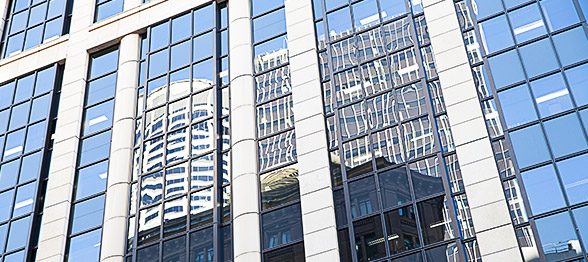What is an Enterprise CMS
- Read time: 5 mins
- Tech level: low
- Key point: Better content and branding are some of the benefits of an enterprise CMS

One of the key differentiators of an enterprise CMS is its ability to manage multiple websites through a single interface and a single sign on. Typically, it's only an Enterprise Class CMS that is suitable to integrate and manage multiple websites across a large organisation.
An Enterprise Class CMS is very different from say a WordPress website (the most hacked website in the world) because they're much more secure, and with the added benefit of being specifically designed to efficiently manage multiple websites and, or large volumes of web content.
Build a great website now, have less problems later
Brand trust, reliability and expertise are the immediate benefits of a website with content that effectively communicates its offering.
Investing in an Enterprise Class CMS is setting your organisation up for online success. If the CMS has been implemented correctly, then you've got better chances of achieving long term benefits such as:
- cost savings through a more efficient updating process
- content that's accurate and up to date
- and branding that’s better and more consistent.

This is because an Enterprise CMS has built in features that make it easier for content editors to keep content up to date without needing to spend time on the technical side of the website.
The less time spent wrangling an interface, the more time that can be spent on the quality of the content, which will enhance the user experience.
The advantages of using an Enterprise Class CMS include:
Advantage 1: focus on the performance of your web content, and less on IT
The first major advantage of an Enterprise Class CMS is that the content team can focus on optimising their content to improve the user experience and sell the benefits of your brand, and less time on any IT issues.
For example, if a team member has problems or forgets any procedures when updating the website, their colleagues, who have also been trained to use the same CMS, can assist with solving any problems – saving time and resources.
The benefits will trickle down to the IT team who can use their time savings from not having to solve small issues throughout the organisation and can focus on their core tasks and on innovation.
Advantage 2: streamlined content maintenance for efficiency
Advantage two of an Enterprise Class CMS in that streamlining content is a big time saver and helps to ensure that content remains current.
Most Enterprise CMS systems can have a content maintenance alert system built in to alert editors for when content becomes out of date. A content maintenance alert system can also be programmed to automatically take content offline once it has become redundant.
Another advantage is its ability to reuse content and update it synchronically. If there are multiple versions and duplications of content within the CMS, it will increase the time it takes to update the website. Enterprise CMS's often have features out of the box that enable an editor to reuse a piece of content multiple times throughout multiple web pages, or even multiple websites. Then updating it synchronically will update that content wherever it's being used.

Enterprise CMS's often have audit trails and the ability to review content in bulk. For example, using the Squiz Matrix CMS, you could set up specific asset listings that show all pages that are up for review throughout the website. Then in a single view, a person could quickly review all web pages and change their status if the content is still accurate. Or in one session, they could go through and update all pages that are up for review.
What's the state of your content currently?
Advantage 3: streamlining the upgrade process, saving time and money
An Enterprise Class CMS streamline upgrade process.
For example, if an organisation had multiple installations of WordPress (let's say 10 across an organisation), that means there's 10 upgrades. However, a single CMS personalisation means just one upgrade.
This is the same with patches, as your IT team doesn't need to spend an unnecessary amount of time upgrading multiple instances of the CMS if one Enterprise CMS is used across the entire organisation. This not only saves time but budget. The savings in terms of time and budget can be repurposed back into improving the content of the website.
The single upgrade process also means that errors and problems such as CMS bugs can be fixed more efficiently. Similar to the single upgrade process, an Enterprise CMS will fix any bugs once instead of having to be fixed multiple times, which is the case for other website platforms such as WordPress.
Advantage 4: reduced training time and costs
Reduced training costs and time is a great selling point of an Enterprise Class CMS for your internal procurements or accounting team.
Training people to effectively use a CMS is critical for the success of any website, and it's much better to build someone’s knowledge in a single CMS so they become a master of that system, rather than a ‘jack of all trades’. Every time someone moves to a different area within an organisation they have to relearn a new system, and that’s not an efficient use of resources in terms of time and budget.
The time and cost it takes to train someone properly are not insignificant and therefore, if you've got a single Enterprise Class CMS across your organisation, you will only need to train people in one system rather than multiple systems.
If it's a common CMS, it will mean that people can collaborate and help each other out across the organisation, rather than seeking out support from say the IT or marketing teams. For example, if someone forgets how to update their web page, then their colleague who also uses the same CMS may know and can share that information – saving time and resources.
Advantage 5: saving costs on hosting

Implementing one centralised Enterprise Class CMS is a lot cheaper and more efficient compared to multiple systems and hosting environment. Hosting multiple CMS platforms will unnecessarily increase costs. Savings could then be used to invest on improving the quality of your hosting environment and service levels.
This also ties in with upgrades. If your hosting company needs to upgrade the server, again it's much more efficient to do it as a single project rather than multiple hosting companies requiring upgrades to their servers. Moreover, if you have engaged multiple hosting companies there could be serious issues if the website needs to be upgraded urgently, particularly if there are critical security issues requiring immediate attention.
Furthermore, by consolidating hosting you're usually placed in a stronger bargaining position if you have a number of websites, or a large single CMS that needs website hosting. So again, there's a number of time and cost savings by centralising the hosting of a single CMS.
Advantage 6: centralised Service Level Agreements
A centralised Service Level Agreements (SLA) is another efficiency that comes from an Enterprise Class CMS. Typically, you'll have an SLA with your hosting company and probably your CMS expert agency. If you've ever had to review an SLA and then get internal sign off within a large organisation, you'll know that it's not a simple process. Having to review a single SLA and get sign off on a single SLA is a lot easier and more time efficient than having to maintain a number of SLAs with various vendors and organisations.
Advantage 7: time saving through streamlined quality assurance checks
Quality assurance (QA) checks can be conducted in batches when websites all sit within the one Enterprise CMS. The ability to run quality checks across large amounts of content is a common feature of an Enterprise CMS. This will mean that QA can be conducted in bulk across an organisation as you can run tools within a single CMS that will evaluate all of the content within that CMS. Doing this will save time and resources. For example, you may run broken link or spell checks across all content within the CMS. If it can be done in a central spot (if the CMS can automate it) then that means you're capturing all the content within your organisation in a single QA process rather than having to do multiple QA processes across multiple CMS platforms.
Advantage 8: easier to launch and deploy new websites
It's easier to launch and deploy websites within a single Enterprise CMS after the first build is complete.
By this I mean that if you've got the momentum of a single CMS and a number of people trained in that CMS, and you've already invested in a large website, then creating sub websites of that large website will be a lot easier.
For example, you may have one main company website and then five sub websites for your sub units. These sub websites may have only minor differences, and if they're all within the same CMS, then there are many advantages, including:
- using the same cascading style sheets (CSS)
- reusing content throughout multiple websites
- the ability to duplicate sites and then tweak them
- and it’s easier to configure the internal search tool to run across multiple websites in your CMS.
Wrapping up
There are many advantages to be found in using one Enterprise Class CMS across your organisation. Hopefully this has given you a good understanding of why it's more efficient and why you'll save money by using a single Enterprise Class CMS. Good luck in your next website project.
Learn more about the benefits of CMS
See how an Enterprise CMS can be advantageous to you and view case studies from previous projects.









